
December 28, 2016
One of the Most Spectacular Songs of Praise in the Jewish Liturgy
Nishmat starts with the wide-open sky and the wings of eagles; it ends deep inside the recesses of the body, in our vital organs.
One of the most spectacular songs of praise in the Jewish liturgy is the prayer known as Nishmat (“Soul of”), after the first word of its opening line: “The soul of all that lives shall bless Your name.” (My attempt at a translation of the poem appears at the end of this essay.) Reserved for Sabbaths and major holidays, it culminates the series of psalms and praises of God with which the morning service begins, and concludes with a blessing that marks the transition to the next part of the service. Interestingly, it also makes an appearance at a parallel juncture in the Passover seder.
The major disagreement concerning this poetic gem regards the identity of its author. Throughout the Middle Ages it was commonly (and startlingly) attributed to Rabbi Shimon Keyfah, also known as Simon the Rock—as in, “this is the rock [in Greek, petra] on which you shall build my church”—also known as the apostle Peter. Seder Avodat Yisrael, a 19th-century critical edition of the prayer book, cites a handwritten manuscript from 1406 CE that reports two different attributions, one to Shimon Keyfah and the other to Shimon ben Shetakh (120-40 BCE), a leading Pharisee of his day.
This dual attribution is rather like ascribing Walt Whitman’s “Song of Myself” to both Abraham Lincoln and Stephen Douglas; not only do the two Shimons come from radically different ends of the ideological spectrum, but neither was noted for his lyrical contributions. At any rate, Rashi’s student Simḥah ben Samuel of Vitry (d. 1105), in his compendium of prayers, responsa, and customs, sharply protested this rumor: